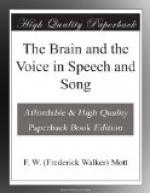singing, is of cerebral origin, and controlled by
centres on the opposite side of the brain, the impulses
being sent down to the respective centres for the
associated movements of the muscles of articulation,
phonation, and breathing, in the same way as they
are sent to the centres for the movements of the arm
or leg. With voluntary breathing the respiratory
centre in the medulla has nothing to do. It is
in fact out of gear or inhibited for the time being,
so that the impulses from the brain pass by or evade
it. There are thus two sets of respiratory nerve
fibres passing from the brain—the one inhibiting
or controlling to the opposite half of the respiratory
centre in the medulla; the other direct, evading the
respiratory centre and running the same course to the
spinal centres for the respiratory movements as the
ordinary motor fibres do to the centres for other
movements. Both sets would be affected by the
lesion (or damage) which produced the hemiplegia.
The inhibitory fibres being damaged, the opposite
half of the respiratory centre would be under diminished
control and therefore the movements of ordinary breathing
on the paralysed side would be exaggerated. The
damage to the direct fibres would prevent the passage
of voluntary stimuli to the groups of respiratory muscles
(as it would do to the rest of the muscles of the
paralysed side), and thus the voluntary movement of
respiration would be diminished—diminished
only and not completely abolished as in the limbs;
because according to the theory of Broadbent, in the
case of such closely associated bilateral movements
the lower nervous respiratory centres of both sides
would be activated from either side of the brain.”
This certainly applies also to the muscles of phonation,
but not to the principal muscles of articulation,
viz.
the tongue and lips. It is not exactly known
what part of the cerebral cortex controls the associated
movements necessary for voluntary costal (rib) respiration
in singing; probably it is localised in the frontal
lobe in front of that part, stimulation of which gives
rise to trunk movements (
vide fig. 16).
Whatever its situation, it must be connected by association
fibres with the centres of phonation and articulation.
[Illustration: FIG. 18]
[Description: FIG. 18.—The accompanying
diagram is an attempt to explain the course of innervation
currents in phonation.
1. Represents the whole brain sending voluntary
impulses V to the regions of the brain presiding
over the mechanisms of voluntary breathing and phonation.
These two regions are associated in their action by
fibres of association A; moreover, the corresponding
centres in the two halves of the brain are unified
in their action by association fibres A’
in the great bridge connecting the two hemispheres
(Corpus Callosum). On each side of the centre
for phonation are represented association fibres H
which come from the centre of hearing; these fibres




